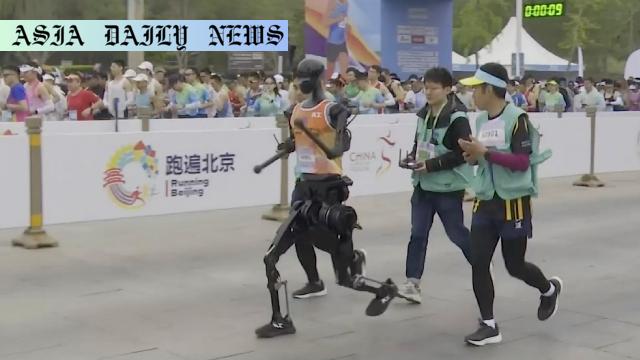Humanoid Robots ran a half-marathon in Beijing, marking the world’s first event of its kind, showcasing advanced robotic technology.
- Humanoid Robots participated in a world-first half-marathon in Beijing.
- 20 Chinese bipedal robots competed in a separate lane for safety.
- Tiangong Ultra, a robot, won the 21-kilometer race in 2 hours 40 minutes.
- The event was organized to showcase China’s advancements in robotics.

The First Humanoid Robot Half-Marathon in History
On a historical day in Beijing, humanoid robots participated in a groundbreaking event – the world’s first half-marathon featuring both humans and robots. The innovative race took place on Saturday, marking an important milestone in both sports and technological advancements. Brought to life by cutting-edge developments in bipedal robotic mobility, this event highlights China’s leadership in pioneering new technologies and serves as a reflection of the government’s investment in robotics and artificial intelligence.
The atmosphere was electric as approximately 20 bipedal robots lined up to compete alongside human runners. Each robot, created by top Chinese companies and universities, showcased unique designs and technical capabilities. Aiming to meet strict criteria, all robots were required to run without wheels, relying solely on humanoid bipedal mechanisms. This bold move away from traditional robotic mobility—often reliant on wheels or tracks—positions the event as a significant advancement in replicating human-like physical functionalities.
To ensure safety, spectators marveled at the organized format where robots operated within separate lanes from human participants. Each robot’s journey began with a one-minute interval and included a human companion to monitor performance. While the event celebrated technological brilliance, it also highlighted the vulnerabilities inherent in robotics through moments such as a robot’s fall at the starting line and penalties incurred for replacing batteries or body components.
China’s Technological Leadership Showcased
The half-marathon wasn’t just a race; it was a showcase of China’s commitment to pushing the boundaries of robotic engineering. Robots like the Tiangong Ultra outshone their competitors by completing the 21-kilometer course in just 2 hours and 40 minutes. Achievements like these symbolize the potential for robotics to become intertwined with human lives—not merely as tools but as partners that can adapt to independent, dynamic environments.
This event reflected China’s position at the forefront of global robotics innovation, not only in terms of technological advancements but also in promoting widespread public engagement. By integrating robots into familiar human-centric environments like marathons, China has opened a new door for conversations around the future of robot-human interactions. These interactions go beyond novelty and delve into how we might co-exist, collaborate, and innovate alongside advanced machines.
Spectators watching the event unveiled their optimism for the future. Many expressed hope that these developments will lead to robots taking on supportive roles, particularly as the population ages and the demand for caregiving and assistance grows. Beyond marathons, the practical implications of such advancements include domestic caregiving, industrial support, and even participation in emergency response scenarios.
Inspirations and Future Possibilities
This groundbreaking marathon is a testament to what happens when human ingenuity meets technological innovation. The humanoid robots displayed their ability to perform tasks that demand endurance, mobility, and environmental adaptation. This sets the stage not just for future races but for a myriad of applications that require similar skills.
The race also served as a mini-laboratory for studying and addressing the limitations of robotic technology. Moments where robots toppled, faltered, or required component replacements served as important lessons for developers. These challenges emphasize the need for robust robotics capable of sustained performance in unpredictable environments. Despite these hurdles, the race’s conclusion painted a bright picture of cooperation between humans and humanoids as they crossed the finish line together.
As robotic technology continues to evolve, events like this marathon will likely become more frequent, evolving into larger, more complex demonstrations of robotic prowess. Rather than being standalone innovations, humanoid robots aim to integrate with and improve the lives of their human counterparts, whether in daily routines or extraordinary undertakings such as this unique race.
In conclusion, the Beijing half-marathon not only showcased China’s advancements in robotics but also highlighted the importance of innovation in solving some of humanity’s most pressing challenges. By bridging science, creativity, and public engagement, this event emphasizes the limitless potential of humanoid robots in shaping our shared future.



Commentary
A Groundbreaking Moment in Robotics
The world’s first humanoid robot half-marathon is an inspiring reminder of the impressive advances in robotics. Events like this showcase not only cutting-edge technology but also the ability of humans and machines to collaborate in ways previously unimaginable. The choice to make this a public race—rather than a closed industry experiment—signals the intention to involve everyday people in conversations surrounding advanced robotics. It’s not just about building innovative machines but about creating experiences that encourage wonder and reflection on how far technology has come.
Challenges Highlight the Road Ahead
While the robots’ participation was undoubtedly exciting, the technical challenges they faced were equally thought-provoking. The sight of robots faltering or requiring battery replacements reminds us of the limitations that come with complex engineering. It’s important to recognize these moments not as failures but as valuable lessons. Overcoming such obstacles will push developers to make more robust and adaptive robots in the future. This iterative development process is a fascinating journey that encourages patience and resilience—qualities that both engineers and their creations seem to embody.
The Future of Collaboration
Perhaps the most heartwarming takeaway from the event is the potential for collaboration between humans and robots. By offering practical applications, such as caregiving and industrial support for an aging population, humanoid robots have the ability to transform society. It’s not hard to imagine a future where robots don’t just compete alongside humans but work together with us to improve quality of life in a myriad of ways. Events like this give us a glimpse of what’s possible while reminding us that mutual growth and understanding are essential as we continue to innovate together.